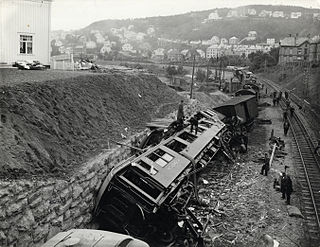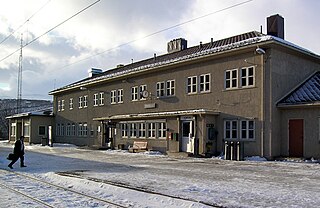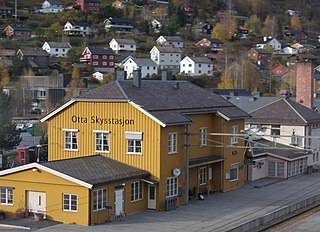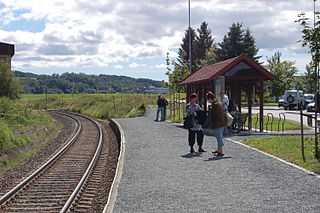
The Rauma Line is a 114.2 kilometres (71.0 mi) long railway between the town of Åndalsnes, and the village of Dombås, in Norway. Running down the Romsdalen valley, the line opened between 1921 and 1924 as a branch of the Dovre Line, which connects to the cities of Oslo and Trondheim. Originally intended as the first stage to connect Ålesund, and possibly also Molde and Kristiansund, no extensions have ever been realized. The unelectrified line is served four times daily with SJ Norge's Class 93, although in the summer the service only operates from Åndalsnes to Bjorli as a tourist service. CargoLink operates a daily freight train.

The Røros Line is a 383-kilometer (238 mi) railway line which runs through the districts of Hedmarken, Østerdalen and Gauldalen in Innlandet and Trøndelag, Norway. The line branches off from the Dovre Line at Hamar Station and runs a more easterly route to Støren Station, where the two lines meet again. The Røros Line also intersects with the Solør Line at Elverum Station. The single track, standard gauge line lacks electrification and only has centralized traffic control south of Røros Station. SJ Norge operate regional passenger trains. In addition the line is used by freight trains hauling lumber and wood chippings.

The Dovre Line is a Norwegian railway line with three slightly different lines which all lead to the historic city of Trondheim.

The Norwegian Railway Museum is located at Hamar in Innlandet county, Norway. It is Norway's national railway museum.

NSB Di 3 is a class of 35 diesel-electric locomotives built by NOHAB for the Norwegian State Railways (NSB). The class was built between 1954 and 1969, and delivered in two series, Di 3a and Di 3b. They are based on the Electro-Motive Division F7 and are equipped with EMD 567 engines. They have a distinct bulldog nose and were numbered 602–633 (a-series) and 641–643 (b-series). The locomotives had a prime mover that gives a power output of 1,305 kilowatts (1,750 hp). The a-series has a Co′Co′ wheel arrangement, while the b-series has (A1A)(A1A). The b-series has higher top speed, but lower tractive effort.

Trondheim Central Station or Trondheim S is the main railway station serving the city of Trondheim, Norway. Located at Brattøra in the north part of the city centre, it is the terminus of the Dovre Line, running southwards, and the Nordland Line, which runs north. The railway is electrified south of the station but not north of it, so through trains must change locomotives at the station.

The Stavne–Leangen Line is a 5.8-kilometer (3.6 mi) railway line between Stavne and Leangen in Trondheim, Norway. The line provides an alternative connection between the Dovre Line and Nordland Line, allowing trains to bypass Trondheim Central Station. The line includes the Stavne Bridge over the river of Nidelva, Lerkendal Station and the 2.7-kilometer (1.7 mi) long Tyholt Tunnel. Construction of the line started during the Second World War by the Wehrmacht, the German military occupying Norway, in an attempt to make the railway in Trondheim resistant to sabotage. Because of the long construction time of the tunnel, tracks were laid in the city streets, but neither route was completed before the end of the war. Construction was placed on hold and the Stavne–Leangen Line did not open until 2 June 1957. At first it was primarily used by freight trains. Since 1988, passenger services from the Dovre Line to Lerkendal Station have been provided, but they do not use the Tyholt Tunnel, instead taking a U-turn back across the Nidelva onto the Dovre Line.

The Trøndelag Commuter Rail is a commuter train service operating in Trøndelag county, Norway. It was operated with Class 92 diesel multiple units by Vy, until 7 June 2020, when SJ Norge took over the contract until 2030. The service provides a commuter service connecting Trondheim to its suburbs, between towns in Innherred and as an airport rail link for Trondheim Airport, Værnes. Although passenger services have operated along the lines since 1864, the commuter train was created with an increase of service with existing rolling stock in 1993. In 2019, the system was used by 1.4 million passengers.

The Nidareid train disaster was a train collision on 18 September 1921 on the Trondhjem–Støren Line railway line, between the stations of Marienborg and Skansen in Trondheim, Norway. The accident occurred the day after the inauguration of the new line to Trondheim, Dovre Line, and one of the trains involved was the inaugural train returning from the celebrations in Trondheim. Six people were killed in the crash, the first serious passenger train accident in Norway.

The Skansen Bridge is a 52-meter span bascule railway bridge located at Skansen in Trondheim, Norway.

Eidsvoll is a railway station located at Eidsvoll in Akershus, Norway. The station is a terminal of the Trunk Line, the Gardermoen Line, and the Dovre Line. Though the Dovre Line and the Trunk Line/Gardermoen Line practically are the same continual railway, there is a naming change at the station, thus making it a terminus for all the three lines. The station serves the Oslo Commuter Rail to Kongsberg and regional trains to Lillehammer, Drammen and Skien. In the summer the paddle steamer Skibladner operates from the docks at the station.

Hamar Station is a railway station of the Dovre Line and the Røros Line located in downtown Hamar, Norway. Located 126.26 kilometers (78.45 mi) from Oslo Central Station, it is served by long-distance and regional trains on the Dovre Line, as the terminus for regional trains on the Røros Line. All trains are operated by SJ Norge, except the regional trains between Lillehammer and Oslo, which are operated by Vy. A side platform and an island platform are in regular use. The station handled 1,062,300 passengers in 2008.

Støren Station is a railway station located in the village of Støren in the municipality of Midtre Gauldal in Trøndelag county, Norway. The station is located at the split between the Dovre Line and the Røros Line, with the former heading south via Gudbrandsdalen to Eastern Norway while the latter heads down Østerdalen to Eastern Norway. Going northwards, the Dovre Line continues to the city of Trondheim, located 52 kilometres (32 mi) to the north. The distance to Oslo via Dovre is 501.20 kilometres (311.43 mi) and via Røros it is 510.37 kilometres (317.13 mi). Støren is served by regional trains on the Røros Line and express trains on the Dovre Line by SJ Norge.

Heimdal Station is a railway station located in Heimdal in Trondheim, Norway. Located 12 km south of Trondheim Central Station on the Dovre Line, it is served by express trains between Trondheim and Oslo Central Station as well as the regional train services Trøndelag Commuter Rail and Nabotåget, all operated by SJ Norge. The station is staffed.

Dombås Station is a railway station located at Dombås in Dovre, Norway. The station is located on the Dovre Line as well as serving as the terminal station for the Rauma Line. The station is served by express trains on the Dovre Line and regional trains on the Rauma Line. The station was built in 1913 when the Dovre Line was extended to Dombås.

Hjerkinn Station is a railway station located at Hjerkinn in Dovre, Norway. The station is located on the Dovre Line and served by four daily express trains each direction to Oslo and Trondheim. There is no settlement at Hjerkinn, though there is an army base as well as the nearby Dovre National Park.

Dovre Station is a railway station located at the village of Dovre Dovre, Norway. The station is located on the Dovre Line and served by one daily express trains in each direction to Oslo and Trondheim since 11 June 2006. The station was opened in 1913 when the Dovre Line was extended from Otta to Dombås.

Otta Station is a railway station located in the town of Otta in Sel, Norway. The station is located on the Dovre Line and served by express trains to Oslo and Trondheim. The station was opened in 1896 when the Dovre Line was extended from Tretten Station to Otta.

Sykehuset Levanger Station, previously Innherred Sykehus Station, was a railway station located in the town of Levanger in the municipality of Levanger in Trøndelag county, Norway. It was located on the Nordland Line. The station was located adjacent to Levanger Hospital. The station was served hourly by the Trøndelag Commuter Rail service operated by the Norwegian State Railways between Steinkjer and Trondheim using Class 92 trains. Until it closed on 11 December 2010, it was among the most used stations of the commuter rail.

Norsk Spisevognselskap A/S, often abbreviated NSS or shortened to Spisevognselskapet, was a Norwegian state enterprise which operated restaurant carriages on Norwegian trains and restaurants at railway stations and railway hotels. The company was established in December 1918, and started a catering service in 1919. Originally owned by the Norwegian Trunk Railway, it was acquired by the state in 1926. Meals served in the restaurant carriages were relatively expensive, although they were available to all passengers. In the 1950s, the company began using serving trolleys on trains.




















